Panasonic Lumix DMC-G7 Review
Panasonic Lumix DMC-G7 Introduction
The Panasonic Lumix DMC-G7 is a prosumer mirrorless camera built around a revised 16 megapixels Four-Thirds CMOS sensor to capture 4K Ultra-HD video at up to 30 FPS. Its high-speed processor and hybrid shutter allow full-resolution continuous shooting at 8 FPS and shutter-speeds up to 1/16000s with a sensitivity range expandable to ISO 100-25600.
Its highly ergonomic body features a built-in 0.5" EVF with Eye-Start sensor. It has 2.4 megapixels of resolution, 100% coverage and an extra-large 0.7X magnification. There are a high number of controls, many of them customizable, plus dual control-dials. A protruding EVF housing and deep hand-grip make the Panasonic G7 particularly comfortable.
The G7 is feature-rich with plenty of drive modes, including 4K Photo mode which can pre-buffer 12 megapixels images at 30 FPS, Sweep Panorama mode, exposure bracketing up to 7 frames, built-in HDR, a built-in Interval Timer, Multiple Exposure mode and built-in WiFi. Movie features are highly sophisticated with full manual-controls, audio gain, stereo sound, stereo audio input and a wind-filter.
Its lens mount makes the G7 compatible with a growing number of Micro Four-Thirds lenses which are often designed for compactness and are now built by several manufacturers.
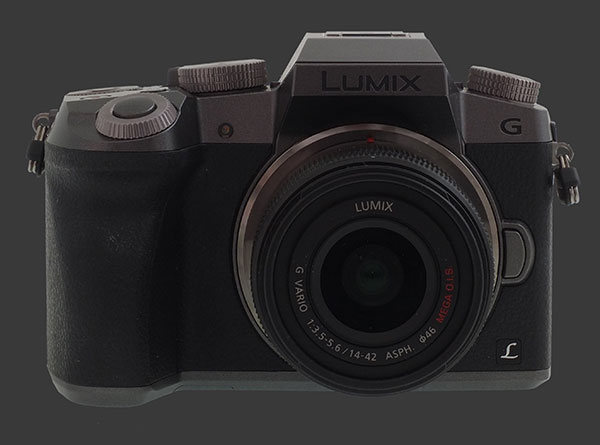
This digital camera review analyses the usability, image quality and performance of the Panasonic Lumix DMC-G7.
Panasonic Lumix DMC-G7 Features
Sensor
- 16 Megapixels CMOS Four-Thirds sensor
- 2X Crop-Factor, 4:3 Aspect-Ratio
- Micro Four-Thirds lens mount
- Ultra-sonic dust-reduction
Exposure
- ISO 200 - 25600 Standard Sensitivity
- ISO 100 Expanded Sensitivity
- Auto ISO, customizable 400 - 25600 limit
- 1/4000-60s Mechanical Shutter-Speed range
- 1/16000-1s Electronic Shutter-Speed range
- Bulb exposure, maximum 2 minutes
- PASM Exposure modes with Program-Shift
- Multi-Segment, Center-Weighed and Spot metering
- Exposure-Compensation, ±5, 1/3 EV increments
- Flash Compensation, ±3, 1/3 EV increments
- AEB, 3 - 7 frames, 1/3 - 1 EV increments
Image Parameters
- Automatic, 5 presetsSunny, Cloudy, Shade, Tungsten, Flash, Kelvin and 4 Custom White-Balance settings
- White-balance fine-tuning along 2 axis in 19 steps
- WB Bracketing, 3 frames, 2 step sizes, 2 axis
- Adjustable Contrast, Sharpness, Saturation and Noise-Reduction, 11 steps each
- 5 Color and 1 B&W modes
- sRGB or Adobe RGB color spaces
Drive
- Continuous Drive, 8 FPS without preview, 5.5 FPS with preview, 100 JPEG or 13 RAW
- 4K Ultra-HD Continuous Drive, 30 FPS with optional pre-buffering
- Self-timer, 2s, 10s or 3 shots @ 10 seconds
- Optional Shutter-Delay, Off or 1-8 seconds
- Time-Lapse, 1-9999 frames, 1s to 100m interval, immediate or delayed start
- Stop Motion Animation, Manual or 1-60s interval
- Sweep Panorama, any direction, Standard or Wide field-of-view
- Automatic HDR from AEB at 1 - 3 EV increments
- Multiple-Exposure, with preview, 4 frames
- Optional Auto Align for HDR capture
- Optional Auto Gain for Multiple-Exposure
Focus
- Focus Drive: AF-S, AF-C, MF or DMF
- Contrast-Detect AF: Pinpoint, Single-Area, Custom Multi-Area, 49-Area, Subject Tracking and Face(Eye)-Detect
- Optional Quick AF
- Optional Eye-Start AF
- Optional AF-Assist lamp
- Optional MF-Assist
- Optional Focus-Peaking, 2 levels, 5 colors
Display & Viewfinder
- 0.5" EVF, 2.4 MP with Eye-Start sensor
- 0.7X Magnification, 100% Coverage
- 3" Rotating touchscreen LCD, 1 megapixel
- Optional Live-View in Manual mode
- Optional Live-Histogram
- Optional Composition Guidelines, 3 types
- Optional Zebra Pattern, 2 levels or customizable
- Adjustable Brightness, Contrast and Saturation, 13 steps each
- Adjustable Tint, 21 steps, red and blue axis
Output Processing
- 4:3 Native aspect ratio
- 3:2, 16:9 & 1:1 cropped aspect ratios
- 16, 8 and 4 Megapixels mode
- JPEG, RAW, RAW+JPEG capture
- 2 JPEG Compression qualities
- Adjustable Tone-Curve, 11 levels for Shadows and Highlights
- 3 Tone-Curve memories
- Optional Long-Shutter Noise-Reduction
- Optional Diffraction Correction
- Optional Vignetting Correction
- Optional Contrast Enhancement, 3 levels
- Optional Resolution Enhancement, 4 levels
- Optional Face-Recognition
Video
- 4K Ultra-HD @ 30 FPS with MPEG-4 codec
- 1080p @ 60 FPS, 720p & VGA @ 30 FPS with MPEG-4 codec
- 1080p @ 24 - 60 FPS with AVCHD codec
- Built-in stereo microphone
- Audio-input gain, 19 steps
- Audio-meters, 2 channels
- Optional Wind-Filter, 2 levels
- Optional Audio Level Limiter
Connectivity
- 4K Ultra-HD HDMI output
- USB 2.0 connectivity
- WiFi (802.11b/g/n)
- NFC-F (ISO/IEC 18092)
Misc
- Dual control-dials
- Traditional mode-dial
- Combined AE-L/AF-L button
- 5 Customizable buttons
- Depth-of-field preview
- Lithium-Ion battery
- SDXC memory
Panasonic Lumix DMC-G7 Capability - What can it do?
The Panasonic Lumix DMC-G7 is an advanced digital camera aimed for enthusiasts with nearly all the capabilities expected of a professional offering except for weather-sealing. This costly feature not only requires a tighter seal along all buttons and seems but also more costly weatherproof lenses.
Lenses strongly influence the suitability of a camera. Native Micro Four-Thirds lenses are more numerous than those for other mirrorless systems. Additionally, as a derivative of the Four-Thirds mount, most lenses for that mount can be used via an adapter on the G7 with full functionality, including autofocus.
Manufacturers currently offer Micro Four-Thirds lenses covering a focal-range of 7 to 300mm, equivalent to 14 - 600mm. This goes from an extremely wide-angle to super-telephoto, covering most needs. Notably absent from the line-up are specialized Tilt-Shift lenses. There are very few macro lenses too. The 2X crop-factor of the G7 gives it more depth-of-field than most DSLRs. Depending on your photography, this is an advantage or not.

The Panasonic G7 uses a hybrid shutter which offers mechanical shutter-speeds of 1/4000-60s and electronic ones of 1/16000-1s. The G7 allows the entire range of ISO sensitivities to be used with either type of shutter. Even longer exposures are possible in Bulb mode but only until 2 minutes, so stair-trails are not possible from a single exposure. AEB offers a class-leading 7-frame bracket. This is usable for Exposure-Fusion or HDR, which this camera can do itself.
While it has full PASM manual controls for both stills and video, the G7 only offers an Exposure-Priority Live-View in Manual mode. Its white-balance options extensive with Auto, Preset, Kelvin and Custom modes. Every single one of these is fine-tunable in 19 steps along 2 axis which makes the G7 capable of handling any type of light-source.
Manual-Focus is incredibly easy on this mirrorless. Not only does it have an ultra-high-resolution 2.4 megapixels EVF, it is also equipped with MF Assist and customizable Focus Peaking. This lets photographers precisely see the area in-focus, better than with any type of SLR. It also offers parallel features for exposure: Blinking Highlights and Zebra Patterns.
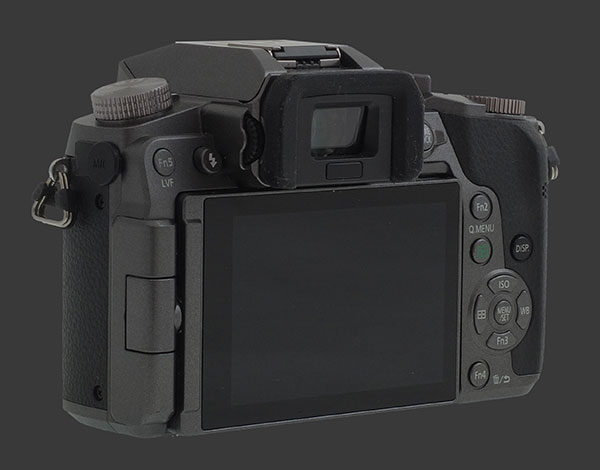
The large 3" touchscreen LCD rotates from a hinge on the left side of the camera. This makes it unwieldy and precarious when shooting at odd angles. The advantage though is that selfies are now possible. There is a standard hot-shoe on this camera, right next to the viewfinder.
Videographers will be happy to know that this new mirrorless record 4K Ultra-HD video at up to 30 FPS which is recording in standard MPEG-4 format. For HD, 1080p at 60 FPS is possible. This can be stored in MPEG-4 or AVCHD format. The G7 is capable of producing both Time-Lapse and Stop-Motion videos. The difference being that the former always advances at a fixed pace, while the latter can be stepped manually.
Panasonic Lumix DMC-G7 Usability - How easy is it to use?
The Panasonic Lumix DMC-G7 is a boxy camera with a sculpted full-height grip. It is designed mostly of straight lines with angled surfaces and rounded corners. The hand-grip provides excellent purchase over the camera and places the shutter-release within comfortable reach of the index finger. For extra comfort, the EVF protrudes nicely from the back of the camera, although that does obscure the rear LCD slightly when looking from above.
This is a medium-sized mirrorless with a moderately light-weight plastic body. Most parts feel solid with the notable exception of the rotating LCD hinge which shows some flex. The combined batter and memory-card compartment door is rigid yet a little thin, so one most be careful when the LCD is rotated outwards or the door is open.
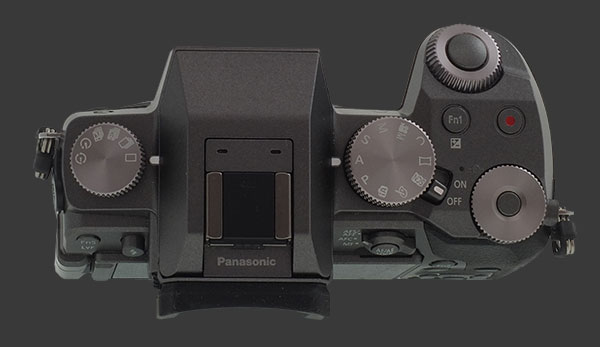
The top plate of the G7 is quite packed. There is a welcome Drive Mode dial on the left shoulder with a good number of options: Single-Shot, Continuous Drive, 4K Photo, AEB, Self-Timer and Interval Timer. The latter can be used for Time-Lapse or Stop Motion. Most of these modes have a specific setting to adjust its behavior in the Camera menu.
The EVF is housed in alignment with the optical axis of the lens mount. Above it, there is a standard hot-shoe, stereo microphone and popup flash. A large Mode-Dial flanks the right side of the viewfinder hump. It has 10 positions:
- Each of the traditional PASM modes get their own position. P offers Program-Shift and Manual offers Bulb.
- Video mode allows recording of video in any PASM mode, as selected in the video menu.
- The Custom mode offers 3 memories for camera parameters.
- Panorama captures a panorama by sweeping the camera horizontally.
- The Scene position groups all 24 modes.
- The Effect position offers 8 image filters.
- Intelligent Auto mode offers automatic operation while letting users specify EC and WB directly. It forces the AF-Assist lamp on which is a shame.
There is a small Fn1 button near the Mode-Dial which normally activates EC. Even though it is ideally placed for modeless operation, this button is sadly modal and must be pressed again to exit EC mode. The amount of EC or FC itself is set via one of the two control-dials which are both located on the top plate. The front one surrounds the shutter-release while the rear one surrounds an unlabeled customizable button. There are a whopping 39 functions to choose from for each button.
Both control-dials are extremely ergonomically placed. They normally control Aperture and Shutter-Speed. Their function can be swapped as can the direction of rotation. Additionally, one control-dial may be set to apply EC without pressing the Fn1 button. There is a function to toggle control-dial functions when a customizable button is pressed. For this, users can choose any one of 12 functions to be assigned to each dial. This results in a highly modal interface which one has to keep track of to avoid unwanted changes.
All four dials have strong detents to prevent accidental movement. Right next to the Mode-Dial, there is a two-position power switch, also with a good detent. The last button on the top-plate is the Video-Record button which serves to start and stop video recording in any mode. Note that only the dedicated Video mode always previews the correct framing for video, so that button is not as useful as one might think.
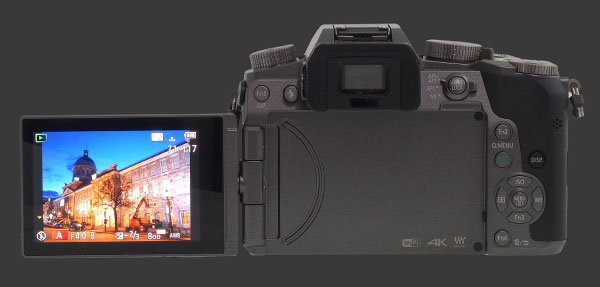
There is a large 3" LCD with 1 megapixels which dominates the back of the G7. It is attached at the left side of the camera which lets it rotate outwards until it faces the front. From that position it can rotate 270° until it is parallel to the bottom of the camera. The display itself is a touchscreen which is not too sensitive and so does not accidentally trigger so often. This can be disabled entirely for safety.
Visibility and viewing angle of the display are very good. The display refreshes quickly and follows motion well. It is unfortunately not Exposure-Priority, except optionally in Manual mode, so exposure is generally not previewed correctly. There is an optional Live-Histogram which is misleading since it is based on the brightness of the display rather than the metered exposure.
What space remains at the rear of the G7 is extremely busy. The 0.5" EVF shows plenty of details thanks to its 2.4 megapixels. It shows 100% coverage and offers a large 0.7X magnification, which rivals the size of the OVF of high-end APS-C DSLRs. There is an extremely useful Eye-Start Sensor which toggles automatically between the EVF and LCD. Optionally, it also triggers pre-focusing which can be useful for shooting subjects in motion.
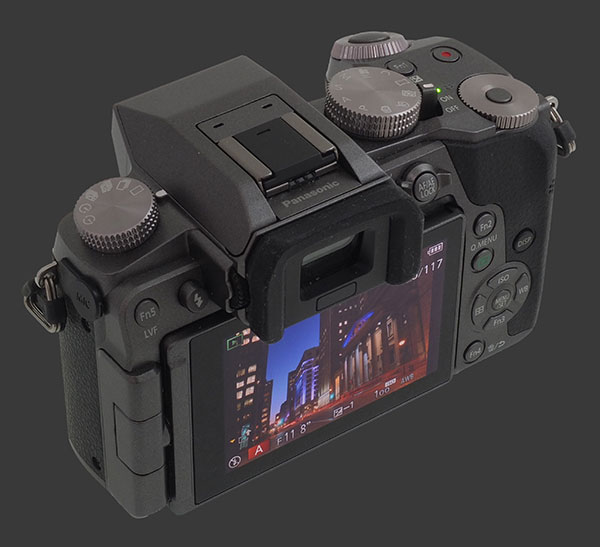
There are two buttons to the left of the EVF. One releases the flash, the other normally toggles the EVF. However, since this is done automatically by the Eye-Start Sensor, it can be assigned to a useful function. On the other side of the EVF, there is a combined AE-L/AF-L button surrounded by a 3-way focus-mode switch. Its options are Single-Shot or Full-Time AF, Continuous AF or MF. The choice between AF-S and AF-F is made by the menu. It is also possible to activate DMF when the switch points to AF-S.
To the right of where the LCD usually is, there are 4 stand-alone buttons, plus 5 arranged as a 4-way controller with central MENU/SET button. The topmost button bye default invokes the Quick Menu which offers a menu of icons to change common settings. In an impressive feat of customization, the menu itself is user-configurable. Below it are the Playback and Disp buttons which work just as usual.
Each direction of the controller is assigned a function:
- Up: Selects ISO. There are options from 200 to 25600, plus a low 100 when ISO Expansion is enabled and an Auto ISO setting.
- Right: Selects White-Balance. Side directions select a WB setting, including one of four custom memories. Down enters a WB Fine-Tuning and WB Bracketing screen.
- Down: Labelled as Fn3, this position is customizable from one of the same 39 functions mentioned above in this review.
- Left: Selects the AF mode: Pinpoint, Single-Area, Custom Area, Automatic 49-Area, Tracking and Face(Eye)-Detection. The focus point or area, depending on the mode, can be set by pressing Down fro there. Pinpoint allows the selection of an exact point while Single-Area allows the selection of an area with eight sizes are available now!
The last customizable button, Fn4, functions as Delete in Playback mode and Back while navigating menus. At the bottom there is a metal tripod mount directly inline with the optical center of the camera. This is ideal for panoramic photography.
Overall, ergonomics of the Panasonic G7 are very good. Only the modality of the EC control is troublesome yet this can be changed by dedicated one control-dial to Exposure-Compensation. One will still have to be careful not to dial EC accidentally but it makes the G7 more predictable. Every important photographic control is within easy reach even without much customization.
 |
Please Support Neocamera
All information on Neocamera is provided free of charge yet running this website is a huge endeavor. Purchases made via affiliate links found throughout the site help keep it running and up-to-date. There is no additional cost to you, so please consider buying via these links to our affilates:
If you found any information on this site valuable and did not purchase via our affiliate links, please considering donating via PayPal:
Any amount will be greatly appreaciated. Thank you for your support!
Panasonic DMC-G7 Highlights

Sensor-Size: 17 x 13mm

Actual size when viewed at 100 DPI
| 16 Megapixels Mirrorless | ISO 100-25600 |
| Micro Four-Thirds Mount 2X FLM | Shutter 1/16000-60s |
| 0.50" Built-in EVF 2.4 Megapixels (0.70X) | Full manual controls, including Manual Focus |
| Automatic Eye-Start sensor | Custom white-balance with 2 axis fine-tuning |
| 2 Axis Digital Level | Spot-Metering |
| Built-in Dust Reduction | Hot-Shoe |
| 8 FPS Drive, 100 Images | Stereo audio input |
| 3840x2160 @ 30 FPS Video Recording | Lithium-Ion Battery |
| 3" LCD 1 Megapixels | Secure Digital Extended Capacity |
Updates
2025.01.18

Fujifilm GFX 2025 Lens Roundup
Lens Review roundup of Fujifilm GFX Medium-Format lenses. Quality, performance and handling of the GF20-35mm F/4R WR, GF30mm F/3.5 Tilt-Shift and the GF55mm F/1.7.
2024.11.18

Best 2024 Photography Gifts for Every Budget
Great gifts for photographers and photo enthusiasts selected for every budget among the best products of 2024.
2024.08.07

Eye Protection Tips for Professional Photographers
The four main considerations for professional photographers regarding eyewear.
2024.07.14

Fujifilm X100VI Review
Flagship fixed-lens compact digital camera with a 40 MP sensor and Image-Stabilization, a first for the series. Retro design featuring dual control-dials, plus direct ISO, Shutter-Speed and EC dials. Its hybrid viewfinder can switch between EVF and OVF mode.
2024.05.09

Fujifilm GFX100 II Review
Flagship 102 Megapixels Medium-Format Mirrorless Digital Camera with 8-Stop 5-Axis IBIS, 8 FPS Drive, 8K Video and 400 MP Super-Resolution capture in a weatherproof and freezeproof body with dual control-dials and dual memory-card slots.
2024.04.03

Fujifilm X-T5 Review
Newest Fujifilm flagship boasting a 40 MP APS-C sensor, 5-axis IBIS with 7-stop efficiency, 15 FPS continuous drive, 6.2K Video capture, dual control-dials and dual SDXC UHS-II slots in a sturdy weatherproof and freezeproof body.
2023.11.20

Best Digital Cameras of 2023
Find out which are the Best Digital Cameras of 2023. All the new Mirrorless Digital Cameras from entry-level to high-end professional.
2023.07.10

Fujifilm X-H2 Review
40 Megapixels APS-C Hybrid Mirrorless Digital Camera with 7-stop IBIS. Fastest shutter ever and 8K video capture. Large builtin EVF with 0.8X magnification and 5.8 MP, plus an Eye-Start Sensor. Packed with features and large number of controls in a weatherproof and freezeproof body.
2023.05.07

Sony FE 20-70mm F/4G Review
Review of the unique Sony FE 20-70mm F/4G lens. The optical zoom of this lens spans ultra-wide-angle and medium focal-length coverage, making it one of the most versatile Full-Frame lenses on the market.
2023.01.15

Huion Inspiroy Dial 2 Review
Review of the Huion Inspiroy Dial 2 tablet, a medium sized drawing surface with dual dials and customizable buttons. Connects via USB-C or Bluetooth 5.0 with Windows, Linux and Android support.
2022.12.08

How to Pack for a Photo Trip
Find out how to pack for a travel photography trip, carry your gear safely while meeting airline regulations.
2022.11.13

Best Digital Cameras of 2022
The best digital cameras of 2022. A short list of the most outstanding models in their respective categories. Choose one for yourself or as a gift.














